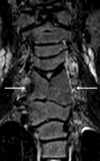Neuroradiological findings in Alagille syndrome
- PMID: 34609904
- PMCID: PMC8722249
- DOI: 10.1259/bjr.20201241
Neuroradiological findings in Alagille syndrome
Abstract
Alagille syndrome (ALGS) is a multisystemic disease caused by mutations in genes of Notch pathway, which regulates embryonic cell differentiation and angiogenesis. Clinically, ALGS is characterized by cholestasis, cardiac defects, characteristic facial features, skeletal and ophthalmologic abnormalities. The aim of this review is to illustrate neuroradiological findings in ALGS, which are less well-known and prevalent, including cerebrovascular anomalies (such as aneurysms, dolichoectasia, Moyamoya syndrome and venous peculiarities), Chiari 1 malformation, craniosynostosis, intracranial hypertension, and vertebral anomalies (namely butterfly vertebra, hemivertebra, and craniocervical junction anomalies). Rarer cerebral midline malformations and temporal bone anomalies have also been described.
Figures











